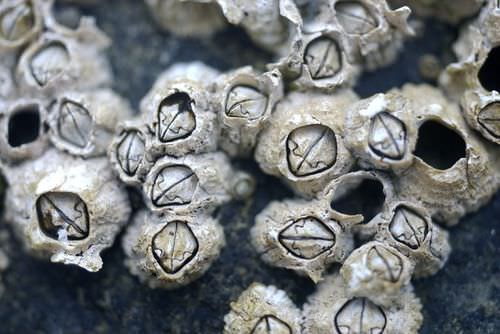9.11 克鲁壳类
章节大纲
-
What are shrimp?
::什么是虾?Shrimp are an example of crustaceans, one group within the . Shrimp live on the ocean floor in many parts of the world. Shrimp are not only food for humans; they are also an important food source for larger marine animals .
::虾是甲壳类动物的一个例子。 世界上许多地方都有虾生活在洋底,虾不仅是人类的食物,也是大型海洋动物的重要食物来源。Crustaceans
::结壳类Crustaceans are a large group of arthropods, consisting of almost 52,000 species . The majority of crustaceans are . Some live in the ocean, while others live in fresh water. A few groups have adapted to living on land, such as land crabs, hermit crabs, and woodlice ( Figure ). Crustaceans are among the most successful animals, and can be considered the dominant aquatic animals. Though small, crustaceans are numerous enough to be the main source of energy for large ocean mammals . They are found as much in the oceans as are on land.
::甲壳类动物是一大批节肢动物,由近52,000种物种组成,大多数甲壳类动物为:一些生活在海洋中,另一些则生活在淡水中;一些群体适应了陆地上的生活,如陆地螃蟹、牧草蟹和木虱(图)。甲壳类动物是最成功的动物,可被视为主要水生动物。虽然小的甲壳类动物数量众多,足以成为大型海洋哺乳动物的主要能源来源,但它们在海洋中和陆地上一样多。A terrestrial arthropod, a species of woodlice.
::一种陆地节肢动物 一种木虱Classes of Crustaceans
::甲壳类Six classes of crustaceans are generally recognized ( Table ).
::一般承认六类甲壳类(表)。Class Characteristics Examples Branchiopoda Mostly small, freshwater animals that feed on plankton and detritus. Brine shrimp Remipedia A small class of blind organisms found in deep caves connected to salt water. Nectiopoda Cephalocarida Small crustaceans, with an eyeless head covered by a horseshoe-shaped shield; has two pairs of antennae and two pairs of jaws. Horseshoe shrimp Maxillopoda Mostly small, with a small abdomen, and generally no appendages . Barnacles, copepods Ostracoda Small animals with bivalve shells. Seed shrimp Malacostraca The largest class, with the largest and most familiar animals. This class has the greatest diversity of body forms. Crabs, lobsters, shrimp, krill, woodlice Can Crustaceans Move?
::克鲁斯塔西安人能移动吗?Remember that crustaceans are an arthropod subphylum, and that arthropod means "jointed feet." As expected, the majority of crustaceans can move. A few groups are parasitic and live attached to their hosts. Adult barnacles ( Figure ) cannot move, so they attach themselves headfirst to a rock or log.
::记住甲壳类是一种节肢动物亚植物,节肢动物的意思是“联合脚 ” 。 正如人们所预期的那样,大多数甲壳类动物都可以移动。 少数动物群是寄生虫,并生活在宿主的周围。 成年谷仓(Figure)不能移动,因此它们把头放在岩石或原木上。Barnacles are non-moving crustaceans. Many barnacles attach themselves to man-made structures.
::甲壳类是非移动性甲壳类,许多谷类附着在人造结构上。Characteristics of Crustaceans
::Crustaceans 的特征Characteristics of crustaceans include:
::甲壳类的特征包括:-
An
exoskeleton
that may be bound together, such as in the
carapace
, the thick back shield seen in many crustaceans that often forms a protective space for the
gills
.
::外层骨骼可能结合在一起,比如在卡帕切,在许多甲壳类动物身上看到的厚厚的后盾,往往形成保护刺的场所。 -
A main body cavity with an expanded circulatory system.
is pumped by a heart located near the back.
::主体腔,扩大循环系统,由位于后方的心脏抽动。 -
A
consisting of a straight tube that has a
gastric mill
for grinding food and a pair of digestive glands that absorb food.
::由直管组成,直管有一个用于研磨食物的胃部和一对吸收食物的消化腺。 -
Structures that function like
to remove wastes. These are located near the antennae.
::结构功能类似于清除废物。这些结构位于天线附近。 -
A
brain
that exists in the form of
ganglia
, or connections between
nerve
cells
.
::大脑以帮派形式存在 神经细胞之间有联系 -
Crustaceans periodically shed the outer skeleton, grow rapidly for a short time, and then form another hard skeleton. They cannot grow underneath their outer exoskeleton. They are very vulnerable during this time, as they lack their hard shell.
::Crustaceans定期抛下外骨骼,短期内迅速成长,然后形成另一个硬骨骼。 他们不能在外骨骼下生长。 在此期间,他们非常脆弱,因为他们没有硬壳。
Crustaceans Reproduction
::Crustaceans 复制Most crustaceans have separate sexes, so they reproduce sexually using eggs and . Many land crustaceans, such as the Christmas Island red crab, mate every season and return to the sea to release the eggs. Others, such as woodlice, lay their eggs on land when the environment is damp. In some crustaceans, the females keep the eggs until they hatch into free-swimming larvae .
::大多数甲状腺动物有不同的性别,因此它们使用卵和。许多陆地甲状腺动物,如圣诞岛红蟹,每季交配一次,然后返回海洋释放卵。其他动物,如木虱,当环境潮湿时,在陆地上产卵。在一些甲状腺动物中,雌性动物保留卵,直到孵化成自由的幼虫。Summary
::摘要-
Crustaceans include crabs, lobsters, shrimp, krill, and woodlice.
::蟹类、龙虾、虾、磷虾和木虱。 -
Features of crustaceans include an exoskeleton that may be bound together.
::甲壳类的特性包括一个可能结合在一起的外骨骼。
Review
::回顾-
What are three examples of crustaceans?
::甲壳类动物的三个例子是什么? -
What are two characteristics of crustaceans?
::甲壳类的两种特征是什么? -
Why do crustaceans shed their outer skeleton.
::为什么甲壳类动物会脱下外骨骼呢? -
What is the carapace?
::什么是卡帕丝?
-
An
exoskeleton
that may be bound together, such as in the
carapace
, the thick back shield seen in many crustaceans that often forms a protective space for the
gills
.


